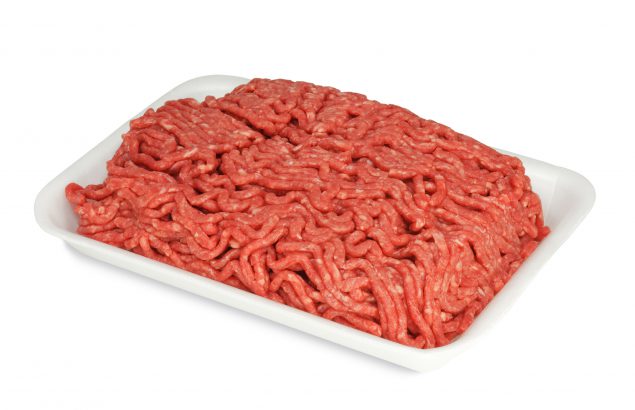2019 E. coli Outbreak Linked to Ground Beef
Final Update

June 19, 2019 at 11:00 AM ET
This outbreak appears to be over. Ill people in this outbreak ate ground beef from many sources. No single supplier, distributor, or brand of ground beef was identified. Consumers and restaurants should always handle and cook ground beef safely to avoid foodborne illness.
CDC, several states, and the U.S. Department of Agriculture’s Food Safety and Inspection Service investigated a multistate outbreak of Shiga toxin-producing Escherichia coli (E. coli) O103 infections linked to ground beef.

Ill people in this outbreak ate ground beef from many sources. Consumers and restaurants should always handle and cook ground beef safely to avoid foodborne illness. Thoroughly cook ground beef and any food that contains ground beef to kill germs. Never eat, serve, or sell recalled ground beef.
Wash hands with soap and water after touching raw ground beef. Use hot, soapy water or a bleach solution to wash items that came in contact with raw meat or its juices.
- Handling ground beef:
- Keep raw meat separate from foods that won’t be cooked before eating.
- Wash hands with soap and water after touching raw meat and before touching other kitchen items.
- Thoroughly wash countertops, cutting boards, plates, and utensils with hot, soapy water or a bleach solution after they come in contact with raw meat or its juices, to avoid contaminating other foods and kitchen items.
- Cooking ground beef:
- Don’t eat raw or undercooked ground beef.
- Cook ground beef hamburgers and mixtures such as meatloaf to an internal temperature of 160°F. Use a food thermometer to make sure the meat has reached a safe internal temperature. You can’t tell whether meat is safely cooked by looking at it.
- For hamburgers, insert the thermometer through the side of the patty until it reaches the middle.
- For foods such as meatloaf, place the thermometer in the thickest part of the meat.
- For casseroles and for sauces that contain ground beef, such as spaghetti sauce or sloppy joe sandwiches, check the temperature in several places.
- After cooking ground beef, refrigerate within 2 hours and use within 3 to 4 days.
- When ordering at a restaurant, ask that ground beef hamburgers and mixtures be cooked to an internal temperature of at least 160°F.
- Storing ground beef:
- Refrigerate or freeze raw ground beef within two hours after purchase.
- If you refrigerate raw ground beef, use within 1 or 2 days.
- Store ground beef in a plastic bag on the lowest shelf of your refrigerator.
- If you break large packages of ground beef into smaller packages for freezing:
- Wash hands with soap and water after touching the meat or its packaging, and before touching other surfaces.
- Use hot, soapy water to clean the area where you divided the ground beef, including kitchen counters and utensils.
- Label your packages with the date they were placed in the freezer and where you purchased the ground beef.
- Thawing ground beef:
- The best way to safely thaw ground beef is in the refrigerator. Cook or refreeze within 1 or 2 days.
For more information about how to handle ground beef safely, call the USDA Meat and Poultry Hotline at 1-888-MPHotline (1-888-674-6854).
No single supplier, distributor, or brand of ground beef was identified that could account for all the illnesses. But certain ground beef products were recalled as part of the investigation. Restaurants, retailers, and institutions should not sell or serve the following recalled ground beef products because they may be contaminated with E. coli O103 and could make people sick:
Grant Park Packing in Franklin Park, Ill., recalled approximately 53,200 pounds of raw ground beef products on April 24, 2019.
- Recalled products were sold in 40-lb. bulk cardboard boxes of “North Star Imports & Sales, LLC. 100% GROUND BEEF BULK 80% LEAN/ 20% FAT” marked “FOR INSTITUTIONAL USE ONLY” with lot code GP.1051.18 and pack dates 10/30/2018, 10/31/2018, and 11/01/2018.
- Recalled products are labeled with establishment number “EST. 21781” inside the USDA mark of inspection on the boxes.
K2D Foods, doing business as Colorado Premium Foods, in Carrollton, Ga., recalled approximately 113,424 pounds of raw ground beef products on April 23, 2019.
- Recalled products were sold in two 24-lb. vacuum-packed packages in cardboard boxes containing raw “GROUND BEEF PUCK” with “Use Thru” dates of 4/14/19, 4/17/19, 4/20/19, 4/23/19, 4/28/19, and 4/30/19.
- Recalled products are labeled with establishment number “EST. 51308” inside the USDA mark of inspection.
Take action if you have symptoms of an E. coli infection:
- Talk to your healthcare provider.
- Write down what you ate in the week before you started to get sick.
- Report your illness to the health department.
- Assist public health investigators by answering questions about your illness.

- As of June 19, 2019, this outbreak appears to be over.
- A total of 209 people infected with the outbreak strain of E. coli O103 were reported from 10 states.
- Twenty-nine people were hospitalized. Two cases of hemolytic uremic syndrome, a type of kidney failure, were reported. No deaths were reported.
- Epidemiologic and laboratory evidence indicated that ground beef was the likely source of this outbreak.
- Ill people in this outbreak reported eating ground beef at home and in restaurants.
- The outbreak strain of E. coli O103 was identified in a sample of ground beef collected from a location where ill people reported eating.
- Traceback investigations of beef eaten by ill people were completed. A common supplier of ground beef to grocery stores and other locations where ill people reported eating was not identified.
- Two companies recalled ground beef products that were sold to restaurants and institutions because they may have been contaminated with E. coli O103.
- Ill people in this outbreak ate ground beef from many sources. No single supplier, distributor, or brand of ground beef was identified that could account for all of the illnesses.
- Restaurants, retailers, and institutions should not sell or serve recalled ground beef.
- CDC recommends that consumers and restaurants always handle ground beef safely and cook it thoroughly to avoid foodborne illness.

- People usually get sick from Shiga toxin-producing E. coli (STEC) 3–4 days after swallowing the germ.
- Symptoms often include severe stomach cramps, diarrhea (often bloody), and vomiting, and usually lasts 5-7 days.
- Some people with a STEC infection may get a type of kidney failure called hemolytic uremic syndrome.
- For more information, see Symptoms of E. coli Infection.
Antibiotics are not recommended for patients with suspected E. coli infections until diagnostic testing can be performed and E. coli infection is ruled out. Some studies have shown that administering antibiotics to patients with E. coli infections might increase their risk of developing HUS, and a benefit of treatment has not been clearly demonstrated.
June 19, 2019
CDC, several states, and the U.S. Department of Agriculture’s Food Safety and Inspection Service (USDA-FSIS ) investigated a multistate outbreak of Shiga toxin-producing E. coli O103 infections.
Public health investigators used the PulseNet system to identify illnesses that may have been part of this outbreak. PulseNet is the national subtyping network of public health and food regulatory agency laboratories coordinated by CDC. DNA fingerprinting is performed on E. coli bacteria isolated from ill people by using techniques called pulsed-field gel electrophoresis (PFGE) and whole genome sequencing (WGS). CDC PulseNet manages a national database of these DNA fingerprints to identify possible outbreaks. WGS gives a more detailed DNA fingerprint than PFGE. WGS performed on E. coli from ill people in this outbreak showed that they were closely related genetically. This means that the ill people were more likely to share a common source of infection.
A total of 209 people infected with the outbreak strain of E. coli O103 were reported from 10 states. A list of the states and the number of confirmed cases in each can be found on the Map of Reported Cases page.
Illnesses started on dates from March 1, 2019, to May 1, 2019. Ill people ranged in age from less than 1 year to 84 years, with a median age of 18. Fifty-one percent were female. Of 191 people with information available, 29 (15%) were hospitalized. Two cases of hemolytic uremic syndrome were reported. No deaths were reported.
WGS analysis was performed on 187 isolates from ill people and 10 isolates from food samples. WGS analysis of 184 isolates from people and 10 from food did not predict any antibiotic resistance; 3 patient isolates had predicted resistance to ampicillin, sulfisoxazole, tetracycline, or trimethoprim-sulfamethoxazole. Standard antibiotic resistance testing by CDC’s National Antimicrobial Resistance Monitoring System (NARMS) of two patient isolates also did not show resistance. These resistance findings do not affect treatment guidance since antibiotics are not recommended for patients with Shiga toxin-producing E. coli infections.
Investigation of the Outbreak
This multistate investigation began on March 28, 2019, when officials in Kentucky and Georgia notified CDC of this outbreak. Epidemiologic and laboratory evidence indicated that ground beef was the likely source of this outbreak.
In interviews, ill people answered questions about the foods they ate and other exposures in the week before they became ill. Of the 159 people interviewed, 125 (79%) reported eating ground beef. This percentage is significantly higher than results from a survey [PDF – 787 KB] of healthy people. Ill people bought or ate ground beef from several different grocery stores and restaurants. Many ill people bought large trays or chubs of ground beef from grocery stores and used the meat to make dishes like spaghetti and sloppy joe.
Officials at USDA-FSIS, in Kentucky, and in Tennessee collected ground beef from a restaurant and an institution where ill people reported eating. Laboratory testing identified the outbreak strain of E. coli O103 in the ground beef collected in Tennessee. A different strain of E. coli O103 was identified in the ground beef collected in Kentucky. This strain was not linked to illnesses.
Two companies recalled raw ground beef products because they may be contaminated with E. coli. Grant Park Packing in Franklin Park, Ill., recalled approximately 53,200 pounds of raw ground beef products on April 24, 2019. K2D Foods, doing business as Colorado Premium Foods, in Carrollton, Ga., recalled approximately 113,424 pounds of raw ground beef products on April 23, 2019. These products were sold to restaurants and institutions.
USDA-FSIS and state regulatory officials collected products for testing at retailers and establishments, and all products tested were negative for E. coli. USDA-FSIS conducted traceback investigations to determine the source of ground beef supplied to grocery stores and restaurants where ill people ate. Ill people in this outbreak ate ground beef from many sources. No single supplier, distributor, or brand of ground beef was identified. Consumers should handle ground beef safely and cook it thoroughly.
As of June 19, 2019, this outbreak appears to be over.
